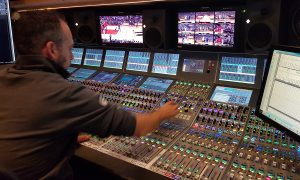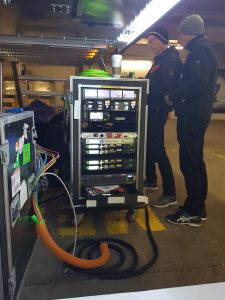Dome Productions Makes the Leap to 4K HDR, Dolby Atmos With DirecTV
The truck provider teamed with the satellite-service provider and MLSE for Raptors-Pelicans NBA game
Story Highlights
Dome Productions continues to push the technological envelope for live sports coverage, producing the Nov. 12 Toronto Raptors-New Orleans Pelicans game in 4K HDR and Dolby Atmos surround sound for distribution to the home by DirecTV. The game is among the first to be produced in the 4K, HDR, and Dolby Atmos formats and distributed live to North American households, joining NBC Sports Group’s efforts for Notre Dame home football games this season.
“We’re really excited to be producing HDR and Atmos,” says Mike Johnson, director, engineering, Dome Productions. “That said, we can’t have any impact on the [production team] because the main HD SDR show has to be equal to or better [than it usually is]. One of the other big benefits is that SDR feeds are enriched by having the HDR-native cameras.”
Dome is no stranger to innovation, having played a vital role in the first live 4K sports telecasts in North America — produced by Rogers’s Sportsnet and Bell Media’s TSN (Dome’s co-owners) — in January 2016. Dome is now helping to lead the next-gen–tech march once again for HDR and Atmos.
Inside the HDR Show: Single-Truck Solution Is Key
After conducting tests with DirecTV at the Raptors’ Oct. 30 home game against the Philadelphia 76ers, Dome went live with its HDR and Dolby Atmos workflow on Monday.
In Toronto, the company teamed with Maple Leaf Sports & Entertainment (MLSE) to produce three feeds for distribution to DirecTV and Sportsnet: 4K HDR with Dolby Atmos, 4K SDR with stereo audio, and HD SDR with stereo audio.
Rather than producing the 4K HDR Atmos show independently from the main HD SDR stereo broadcast, Dome opted for a single-truck solution using its Vista mobile unit in which the primary feed was produced in HLG (hybrid log gamma) HDR, with replays produced in SDR and upconverted before they hit the switcher. The additional 4K SDR and HD SDR feeds were downconverted to SDR for distribution.
“We didn’t want to compromise the HD show or add to the workflow unnecessarily,” says Johnson. “Our push is to leave all the EVS records in the tape room in SDR and then [convert] EVS replays back to HDR at the production switcher. By leaving all of that EVS archive material in SDR, [the crew] can do their melts and seamlessly move on to the next show or pull in stuff from previous shows.”
Dome’s 16-camera complement comprised primarily Sony HDC-4300 systems producing native 4K HDR (although PTZ and POV cameras were upconverted from HD SDR).
For backhaul, Dome used MediaKind HEVC encoders to send the 4K HDR video and DD+ Atmos audio feeds to DirecTV entirely via IP. From Toronto, Dome linked up with its DomeNet dedicated fiber network, then crossconnected to AT&T’s fiber network, which delivered the signal to DirecTV’s Los Angeles Broadcast Center (LABC) for distribution to subscribers with 4K HDR-capable set-top boxes.
Inside the Dolby Atmos Show: Serving Multiple Masters
The audio side of the production was based on a Calrec Apollo console, which handled two feeds: the 5.1+4 Atmos mix distributed to DirecTV and the stereo shows distributed to Sportsnet.
“During [a test] a couple weeks ago, I was really impressed at how good the Atmos [experience was] for an NBA game,” says Johnson. “As I’m watching the opening to game, listening in the audio room, it felt like I was sitting at home watching TV but also in a seat at the arena. Yes, I’m getting an introduction to the game and seeing the clips fly by, but then, up above, I’m also hearing PA and [natural arena sound]. I’m watching a delivered TV program and also feel like I’m in the venue because I’ve got the PA and it sounded quite natural, actually. It was really impressive.”
Dome Productions assigned two dedicated A1s — John Hunter and John Rootes — to build up the console and lay out a detailed routing and mixing strategy for the Atmos show. They were able to take advantage of the Waves system integrated in the Calrec Apollo to provide upmix contribution. Additional audio monitoring was provided by four more Neuman speakers mounted at ceiling level facing down. Dolby Solutions Engineering Director Mike Babbitt was onsite to assist in setup and training related to encoding support.
“Once again,” says Johnson, “we had to be very mindful of our stereo feed deliverable because that had to be equal to or better than what we were doing on [typical HD stereo shows]. That is our main client on the truck, so we made an extra effort to [ensure] they were happy and satisfied.”
Dome also deployed Waves DSP servers for audio-signal processing to take the stereo feeds from the audio console, upmix them to 5.1 surround to hit the switcher, and produce the final output downmix back to stereo.
“That was really effective and just owed to our [A1s’] due diligence in terms of how they’d built up the console and [workflow],” says Johnson. “On the Atmos side, we feel like we’re pretty much set, and we’re happy with what we have created so far. We have effective monitoring within the truck, and the encoding solution provided by Dolby worked well.”
On the Horizon: IP To Help Pave the Way for More HDR, Atmos
Although no formal announcements have been made, Johnson sees DirecTV as “a group that is working hard to deliver a lot of [4K, HDR, and Atmos] content, so I’m sure they’re interested in [producing] future games.”
In addition, he believes that the continued maturation of IP-based tools and infrastructure will help streamline the 4K- and HDR-production ecosystem. Dome has assembled a small IP facility in Toronto that it is using to test out SMPTE ST 2110 workflows and determine how the new media-over-IP suite of standards could help streamline 4K and HDR workflows in the future.
“IP is definitely going to be a big help in this area,” says Johnson. “But the technology is still struggling, and, at least for us, I think it’s still a way away. We’ve seen a lot of vendors implementing IP solutions with compression or working with an IP [routing] core but using [SDI] gateways, which is really imposing if you’re doing 4K. So creating a model that is IP from source origination right through the production equipment and onto delivery is very important for success in the future.”


